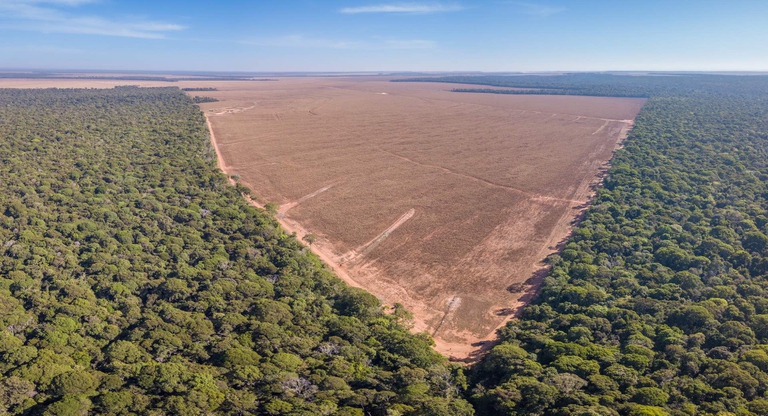https://www.lifegate.it/addio-resilienza-boschi-rischio-alberi-conosciuti
- |
- 16,425 tree species out of a total of 47,282 are at risk of extinction.
- The data is present in the report on the state of trees published by the International Union for Conservation of Nature during COP16 in Cali.
- “The main threat factor for a third of the species assessed in the report is deforestation,” according to Giorgio Vacchiano.
More than a third of known and cataloged tree species (38 percent) are now at risk of extinction.This is what emerges from report on the world state of trees developed by the International Union for Conservation of Nature (IUCN) and presented on 28 October during a collateral event at the Cop16 on ongoing biodiversity in Cali, Colombia.
A disconcerting result that certainly doesn't help to keep hopes high at a time when, no matter how hard we try to invest in a positive narrative, bad news often tends to overshadow the good.If we want to present the data in another way, in fact, we discover that that 38 percent is equivalent to 16,425 tree species out of a total of 47,282 which have been cataloged and which therefore represent more than a quarter of all the species included in the infamous Red List, a sort of barometer of the state of biodiversity known to date.
Trees support life on the planet
An exercise that I have learned to do, and that I always suggest to anyone who wants to better understand the different facets of the term "interconnection", is to always ask myself what we risk losing if we let go of a species or an ecosystem, what are its functions and what its value is - net of the fact that I remain convinced that every organism living on the planet has the right to continue its existence regardless of its contribution to our survival.
If we ask ourselves this question about trees, we would discover with relative ease that they literally support life on the planet.They regulate the cycle of carbon, water and nutrients necessary for the formation of soil, provide oxygen, regulate the climate and are inextricably linked to other plants or species belonging to the animal or fungal kingdom.Not to mention the human being:over 5,000 of the tree species on the IUCN Red List are used for construction timber and over 2,000 species for medicines, food and fuel.
“Especially in tropical areas, trees provide active ingredients that are very useful for our health and the production of medicines,” he explains Giorgio Vacchiano, researcher and teacher in Forest Management and Planning at the State University of Milan, and author of the book The resilience of the forest, published by Mondadori.
Throughout the world, there are 35,000 plant species - therefore trees and plants as a whole - used for medical purposes, a figure that represents only 15 percent of the estimated existing ones.Therefore, if we consider that cancer and heart disease together are responsible for at least 70 percent of deaths globally, and that, as demonstrated by the recent Covid-19 pandemic, the emergence of new diseases is far from being a remote hypothesis, it is easy to understand how investing in the research and conservation of plants and fungi is of fundamental importance.
Just think about Quillaja soapwort, an evergreen tree native to central Chile, whose bark contains saponins, used as adjuvants in some anti-Covid vaccines and which produces a substance used in vaccines against herpes zoster, and appears to also have effects against malaria and tuberculosis , or a Cinchona calisaya, or cinchona tree, present in Peru and Bolivia, with proven febrifugal, tonic, stimulant, antipyretic, antimalarial and antirheumatic virtues.
The danger of deforestation
“The main threat factors for a third of the species assessed in the report are deforestation, which in tropical areas is mainly due to agriculture and livestock farming, and the unregulated harvesting of valuable wood.Factors that seem distant from us but which in reality concern us directly given that, for example, we are importers of wood but also of food products such as palm oil and soya to mainly feed farm animals", he explains Vacchiano.
Although the extent of illegal deforestation is difficult to quantify precisely, the scars on the landscape are clearly visible to the naked eye when crossing Central and South America.A painful exercise that accompanied me for months while I conducted WANE – We Are Nature Expedition, a reportage on the state of biodiversity along the Pan-American Highway.Kilometers of forest cleared and replaced by oil palm monocultures, whose need for water is well known, which is bringing the Mayan populations to their knees in the Petèn and Quiché regions of Guatemala, part of what is also known as the arid corridor .Not to mention illegal farming, whose meat and derived products reach the United States and Europe.Hundreds of thousands of cows introduced into large tracts of land that were once home to monumental ceiba trees, and which today still bear the marks of the slash and burn.

Currently, between 20 percent and 40 percent of global wood production comes from illegal deforestation practices, especially in tropical areas.A trend that especially brings the poorest countries to their knees, whose governments lose around 15 billion dollars a year which could instead be used to heal the internal economic and social situation.
Among the varieties of wood most imported into Europe are Burmese teak and mahogany.The latter is extracted from trees of the delle family Meliaceae which includes five different species of African mahogany all included in CITES, the Convention on International Trade in Endangered Animal and Plant Species, and whose illegal harvesting is bringing the Congo rainforest to its knees.A situation that we also find in Peru, whose 80% of mahogany, until the early 2000s, was exported to the United States, in violation of the aforementioned Convention.But Italy is no exception given that, at least according to a report published in 2001 on imports of illegal timber into the European Union, as much as 40% of the tropical timber imported from our country was illegally felled, for a total of approximately 45 million euros a year of material coming from illegal deforestation in Indonesia.
One of the things that should always be kept in mind when talking about deforestation is that it is not just trees that pay the price but also other forms of biodiversity.What for many of us are postcard views or places to explore during holidays, for 350 million people are in fact the home and place on which they depend for the supply of various ecosystem services.Of these hundreds of millions of people, many belong to native populations for whom the disappearance of the forests would be equivalent to the cancellation of their history, their culture and their traditions.

Possible solutions to deforestation
“In tropical areas, some solutions to combat deforestation are linked to the support that we will be able to give to the nations and indigenous communities that preserve the knowledge to be able to use forests and wood without compromising their survival,” he continues Vacchiano.“Let's remember the case of the Amazon nut, a tree whose fruits we also consume, but which is pollinated only by animals that live in the intact forest.This means that it is not possible to grow orchards of it, as some might think. Bertholletia excelsa lives only in undisturbed forest.For this reason, it is essential to encourage, through cooperation projects, a local economy based on the collection of Brazil nuts, reconciling the livelihood of local populations with the conservation of the forest which, therefore, automatically becomes a priority also for a healthy, resilient and fair economic supply chain. ”.
If working locally is essential, so is raising awareness of the entire supply chain in that part of the world responsible for much of the consumption of goods from tropical forests.“It is very important to turn to large-scale retailers who, for all the products arriving overseas, have the upper hand more than all consumers. These, in fact, can certainly inform themselves - they must do so - but we must also admit that they often do not have the power of choice or they do not have the tools, in terms of data made available to them, to understand where a product really comes from.It is up to the large supply chains to clean up their production chain and make concrete commitments to subject the areas from which the wood comes from to the zero deforestation objective.To date, in fact, none of the 100 most important companies in the world for the supply of tropical wood have clear commitments in this sense.It is therefore a shared responsibility to carry out concrete action both from below, through consumers, and from above".
The risk of pesticides and the climate crisis
Although deforestation does not have alarming rates in temperate regions, here there are other factors that threaten the survival of forests, primarily pesticides and the climate crisis, but also of some of their inhabitants.The IUCN red list, in fact, continues to fill with new protagonists from a history that we must not take for granted.Last, in order of appearance, the Western European hedgehog (Erinaceus europaeus), which has gone from minimal concern to almost threatened.Monitoring activities, in fact, have highlighted that the decline of the species may have exceeded 30% in the last decade, putting it seriously at risk.
“Although trees have great resilience to drought and fires, if these events occur with increasing frequency they risk becoming a major threat.This is why, even in the heart of temperate Europe, we are starting to talk about assisted migration, that is, introducing into the forests some varieties of species - or even different species - which due to their physiological and evolutionary characteristics are more resistant to heat and dryness. .In this way we can help some species of trees which, by moving very slowly - i.e. only through their seeds - are unable to keep up with the shift in the climatic bands on which their survival depends.“Unfortunately, to date, we still know little about the genetic characteristics of most of our most common species, such as beech, spruce, Scots pine... The first studies on genomes linked to drought resistance began just a few years ago.Among these, the Rescue project, launched by the University of Pavia in the Ticino Lombardo natural park, which aims to associate the genetic characteristics of the oak forest with the propensity of this species to decline, so as to try to identify single individuals or varieties with resistance important genetics and use them to reconstitute the forests of the future".
It takes constant effort
While at COP16 Governments are busy discussing documents whose approval or otherwise depends on interests far from scientific reality, in 2023 deforestation was progressing at a rate 45 percent higher than what would have been necessary to respect the commitments undertaken by 140 countries (including Brazil, China, Russia and the United States) to stop deforestation by 2030.
Yet, despite the difficulties, despite the steps forward that seem like crumbs compared to the problem, we have a collective responsibility to remain anchored to the reality of things.We have a duty to continue to look at the elephant in the room, finding all possible solutions to get it out and give it the freedom it deserves.
